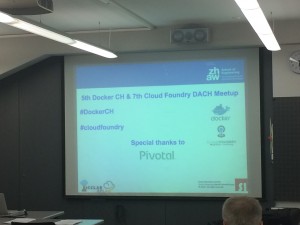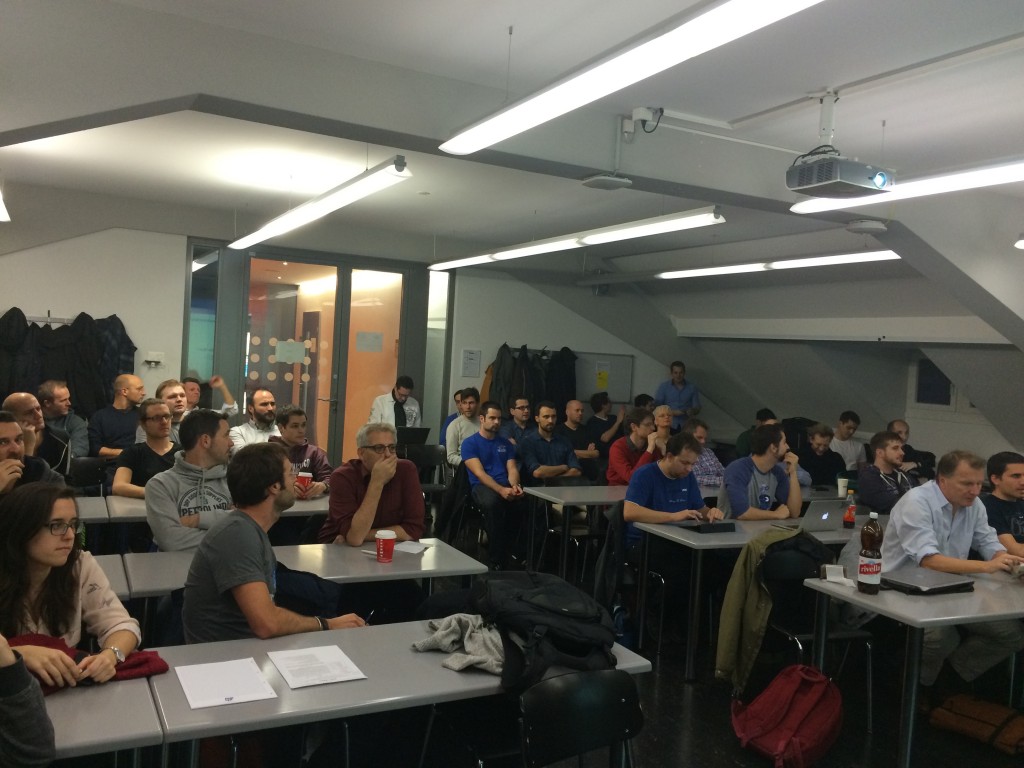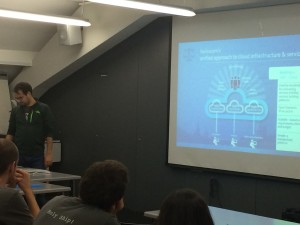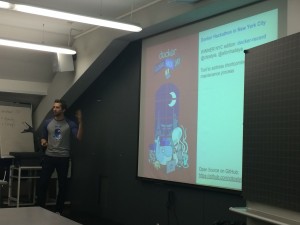 Last night we organised the 5th Docker Switzerland user group meetup in Zürich. The event was co-located with the 7th CloudFoundry DACH user group meetup as well. We were overwhelmed to see the participation, the meetup page showed about a 100 people registered for the event, but about 75 showed up. Still it was a packed room at the ZHAW Lagerstrasse building in Zürich.
Last night we organised the 5th Docker Switzerland user group meetup in Zürich. The event was co-located with the 7th CloudFoundry DACH user group meetup as well. We were overwhelmed to see the participation, the meetup page showed about a 100 people registered for the event, but about 75 showed up. Still it was a packed room at the ZHAW Lagerstrasse building in Zürich. 
We started with a Docker talk by Dominik Suter from Swisscom about their experience in using Docker & Flocker to deliver stateful services.
Dominik presented the architecture used as Swisscom to deploy and manage stateful services on CloudFoundry. Their solution exploits ClusterHQ’s Flocker to manage storage for Docker containers. Using Flocker, their architecture is able to restart a failed container from any host to any other host without any state loss.
Thereafter we had a Cloud Foundry talk from Patrik Nagel, from Pivotal, about the Cloud Foundry experiences in the field.
 Patrick gave us a perspective on how Pivotal is presenting Cloud Foundry to enterprise customers, which benefits they could take out of it and how best to use it. In particular he talked about the challenges of converting legacy monolithic applications to cloud-native, microservices-based applications.
Patrick gave us a perspective on how Pivotal is presenting Cloud Foundry to enterprise customers, which benefits they could take out of it and how best to use it. In particular he talked about the challenges of converting legacy monolithic applications to cloud-native, microservices-based applications.
And finally we had a very entertaining talk (slides) by Jürgen Cito, a PhD candidate from the Univ. of Zürich who won the very recent Docker New York Hackathon. He developed a neat solution to the classical problem of making a container – you have a pretty clear idea what you want to put into it, you have a first go at it, realize you’ve missed out some files, try again, find another issue, try again and by the time you’ve a working container, you’ve forgotten the concrete steps you’ve taken and cannot easily reproduce the image. docker-record enables you to start a base image, work in the base image until the container is doing what you want and it records the sequence of operations required to bring the base image into the state you want. It then uses some sensible heuristics to generate a Dockerfile from this sequence. As an output of a hackathon project, it was impressive indeed; of course, it can be evolved in many dimensions and Jürgen indicated that he would be very happy to have contributions from anyone who’s interested.
We ended the talk session with these 3 talks and proceeded to the excellent refreshments at the ZHAW cafeteria, sponsored by the kind folks at Pivotal, a big shout out to them!
There was about an hour or longer for after-session talks and networking over some delightful food and beverages.
I thank the speakers, the co-organisers (Swisscom, Pivotal and us!) and the participants for making this a successful meetup.
We will see you again shortly!

